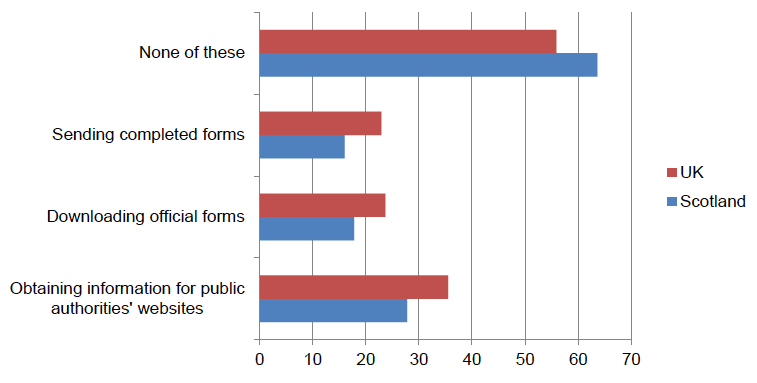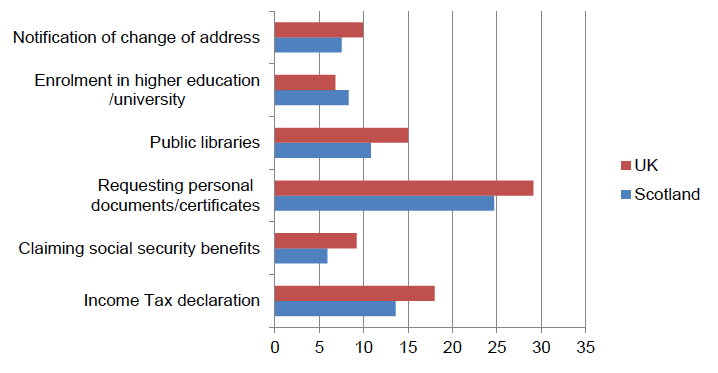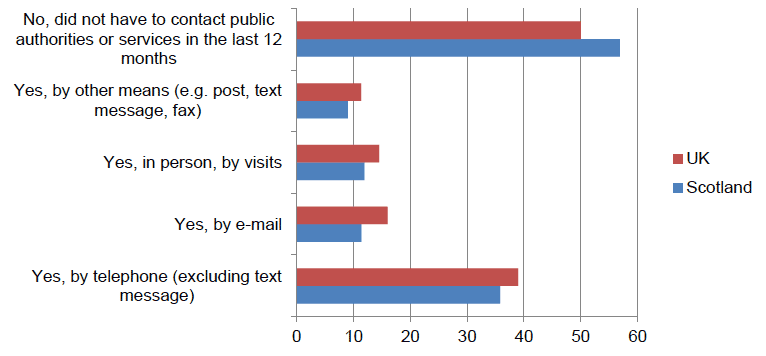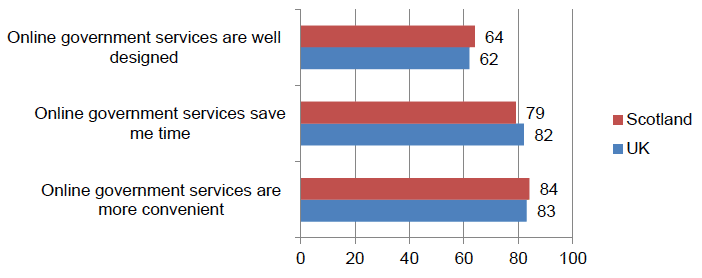A Commentary on Scotland's Digital Performance
A commentary on how Scotland is performing across aspects of the digital strategy using currently available data.
Digital Public Services
"Our public sector makes best use of digital technologies to deliver high quality, efficient and responsive services, enabling access to information and services whenever and wherever citizens want them."
Scotland's Digital Public Services progress has been measured using the following sources:
- Scottish Household Survey (SHS)
- ONS Opinions and Lifestyle Survey
- Ofcom Communications Market Report
The measurement and benefits framework for Digital Public Services has already been developed. The Measurement and Benefits Framework contains 16 measures which provide comprehensive coverage of the main benefits areas arising from the activity set out in the "Scotland's Digital Future - Delivery of Public Services Strategy".
For the purposes of both Digital Scotland Performs and the Digital Public Services Measurement and Benefits Framework, work is underway to determine the Scottish Government's preferred sources for tracking progress. The Scottish Household Survey, the ONS Opinions and Lifestyle surveys and Ofcom's Communication Market Report are currently the best available sources.
It should be noted that the Scottish sample size for the ONS survey is considerably smaller than the sample size for the Scottish Household Survey18.
Use of Digital Public Services
Among internet users in Scotland, 62 per cent had ever used a Local Authority website for any purpose and 64 per cent had ever used a Government website for any purpose (Figure 9). The most commonly stated reason for using a public authority website was to find information.
Figure 9: Use (ever) of public services on the Internet in Scotland 2012 (proportion of Internet users)
Source: Scottish Household Survey, 201219
| Local authority website | % | Government website | % |
|---|---|---|---|
| Finding information | 52 | Apply for road tax | 39 |
| Download a form | 13 | Apply for or renew my TV licence | 20 |
| Access services like report a fault, renew library books | 11 | Apply for or renew passport | 16 |
| Make payment like council tax or parking fine | 10 | Look for information about health services | 13 |
| Ask a question | 8 | Register to vote | 11 |
| Make a complaint | 5 | Complete income tax assessment | 10 |
| Participate in a discussion forum | 1 | Look for information about health or healthy living | 9 |
| Some other purpose | 9 | Apply for benefits | 6 |
| Any purpose | 62 | Other | 9 |
| None of these | 38 | Any purpose | 64 |
| None of these | 36 |
The following results from the ONS Opinions and Lifestyle Survey allow for Scotland and UK comparisons. The latest statistics available on EU level are from 2010, and for this reason no comparison with the EU has been included at present. Overall, the results from the survey suggests that Scotland lags behind the UK as a whole.
- 27.8 per cent of Scottish respondents had contacted or interacted with public authorities or public services over the Internet to obtain information. This compares with 35.5 per cent of UK respondents.
- 17.8 per cent in Scotland and 23.7 per cent in the UK had downloaded official forms, and
- 16 per cent and 22.9 per cent in Scotland and the UK respectively had sent completed forms over the internet.
Figure 10: Proportion of people who have contacted or interacted with public authorities or public services over the Internet for personal use for any of the following activities in the last 12 months
Source: Opinions and Lifestyle Survey, 2013

Similarly, there are differences between the activities undertaken by adults in Scotland and the UK as a whole (Figure 11).
- The most common activity among users of public authorities or public services websites was requesting personal documents/certificates (29.1 per cent in the UK and 24.7 per cent in Scotland).
- 18 per cent of UK respondents stated to have submitted their income tax declaration online, compared with 13.6 per cent in Scotland.
- The least common activity among users of digital public services in Scotland was claiming social security benefits (5.9 per cent compared with 9.2 per cent in the UK).
- The least common activity in the UK was enrolment in higher education/university (6.8 per cent in the UK compared to 8.3 per cent in Scotland).
Figure 11: Proportion of adults in Scotland and the UK who have used websites of public authorities or public services over the internet for of the following activities in the last 12 months
Source: Opinions and Lifestyle Survey, 2013

Figure 12 shows the proportion of people who contacted public authorities or public services using methods other than websites.
- 39 per cent of people in the UK and 35.8 per cent in Scotland contacted public authorities or services by telephone.
- 16 per cent in the UK and 11.4 per cent contacted public authorities or services by e-mail, and
- 14.5 per cent of UK respondents and 11.9 per cent of Scottish respondents contacted public authorities or services in person.
Figure 12: In the last 12 months, did you contact public authorities or public services for personal reasons using methods other than websites?
Source: Opinions and Lifestyle Survey, 2013

Attitudes to Digital Public Services
The most recent Ofcom Communications Market Report20 comparing attitudes among users of e-government services in Scotland and the UK (Figure 13):
- 82 per cent of users of government online services in the UK and 79 per cent of users in Scotland found that online government services save them time.
- 62 per cent in the UK and 64 per cent in Scotland found online government services to be well designed, and
- 83 and 84 per cent in the UK and Scotland respectively found such services more convenient.
Figure 13: Attitudes among users of e-government services in Scotland and the UK (% agree strongly or slightly)
Source: Ofcom Communications Market Report: Scotland, 201321

Contact
Email: Digital Scotland
There is a problem
Thanks for your feedback